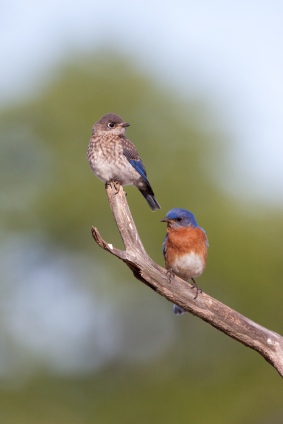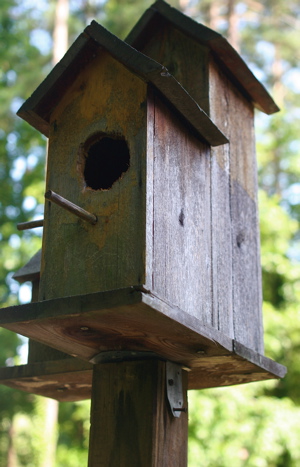-
bluebird houses alone may not cut it
The “Bluebird of Happiness” is one special little songbird that many backyard birders try to entice to their yards. The task can sometimes prove fruitless without the right combination of elements.
First there’s shelter, in the form of nest boxes, or bluebird houses. But don’t expect success with just slapping up a house. Proportionally-sized for Eastern and Western Bluebirds, these houses have certain features required for a successful brood. A predator guard is a plus, and having a duplicate bluebird house nearby may help with the fierce competition by non-native birds like the House Sparrow. Placement is important too, as Bluebirds prefer their nest boxes in open spaces. Shelter also involves cover, protection from predators in the form of mature trees and shrubs.
Now bluebird houses can run the gamut from your basic nest box (which serv
es the purpose well) to detailed copper roof houses, and decorative artisan’s works. The main thing is proportion and size, and drainage. Some bluebird houses will have a raised screen on the floor to prevent parasites, others have built in predator guards, and some have clear acrylic viewing windows to check the progress of nestlings without disturbing them. Some may have all these features, while others may have none of them. You usually get what you pay for in this instance, but again, a basic nest box will
likely do the trick.
Next is the feeder…Bluebirds are not seed eaters, and are not very likely to frequent this type of bird feeder. Traditional bluebird feeders are a “fly-in” style. They have have holes for the birds to enter and leave. Not many other species will use this kind of feeder…don’t ask me why bluebirds do! On occasion, I’ve seen Black Capped Chickadees enter our feeder in search of the coveted live mealworms. Tray feeders will also entice bluebirds if their favorite foods are offered. Number one choice…live meal worms. Once discovered, they’ll usually stick around for a daily offering of the juicy treat.
The last recommendation would have to be a birdbath. Fresh water offered on a consistent basis has got to be the single, most effective way to attract any wild birds. Especially in winter, a heated bath is a popular hangout where you’ll see many grateful little songbirds! Last winter, our Eastern Bluebirds over-wintered, and toughed out one of the most miserable winter seasons i can remember. Largely because of the heated bird baths, and live meal worms which were fed twice daily. Two successful broods last spring were truly a joy to watch fledge and grow. Once success is achieved…you’ll be hooked on Bluebirds…Happy Birding!
- Bird Accessories, Bird Houses, Blue Bird Houses, Bluebird Houses, Decorative Bird Houses, Uncategorized, Wood Birdhouse
Got Squirrel Damage to Blue Bird Houses?
Okay…so this may not be a bluebird house, but it does represent a typical squirrel-enlarged entrance. Has this happened to any of your birdhouses?
Early fall is the perfect time to clean birdhouses in preparation for winter. Resident birds like chickadees, titmice, and wrens will use houses to roost on cold winter nights. Our bluebirds actually stuck around and over-wintered here in North Georgia last year, so blue bird houses should also receive a thorough cleaning.
An old spatula works well to remove nesting materials, and makes the perfect scraper to remove stuck-on debris. Discard nest material away from the birdhouse, as this will likely attract predators. For the safety of your health, never breath in the dust from the nest materials either. Rubber gloves are helpful too.
To salvage an enlarged entrance and restore your birdhouses, predator guards are available. Simple metal portals work well, and fit right over the entrance, denying large birds or squirrels back inside the house. Two small nails will tack these down securely and in a jiffy! Decorative predator guards are also available, and will undo the damage done to your birdhouse.
-
Blue Bird Houses May Not be Enough
Silly me! I seriously thought that by placing blue bird houses in the yard the sweet birds would just appear and decide to take up residence. Not the case though. After some time, the bluebird feeder was introduced with offerings that weren’t too enticing to bluebirds. Suet crumbles, bluebird banquet, roasted mealworms, and a host of other foods claiming to be” their favorite” were not attracting bluebirds to the yard.
Then after biting the bullet so to speak, live meal worms were offered and it worked…in fact, it worked great! I noticed in the dead of winter there were eastern bluebirds in my yard…everyday! There’s a heated bird bath in the back, and they frequented it daily. Now added to the list of chores was feeding the worms everyday, but it was just so rewarding to watch these sweet little birds chowing down!
When it started to warm up, the bluebirds were busy building a nest of pine needles in one of blue bird houses. In and out for a few days, the nest was completed quickly. I watched the process over the next few we
eks, afraid to even open the house and peek inside. The parents dutifully fed the chicks mealworms over the next few days. Feeder to house, house to feeder, I watched in delight.
Fledglings! Three healthy bluebird chicks learned to fly. I watched as they’d follow their parents over to the meal worm feeder, land on top and scream for food. After a few days they learned to enter and exit the openings to get their own worms. This was very cool to witness, and I would suggest to anyone with the least bit of interest in Bluebirds to try it and see!






